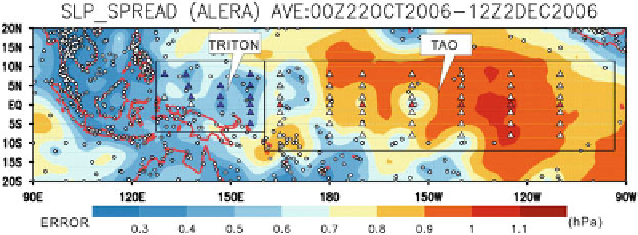Geoscience Reference
In-Depth Information
Fig. 21.1
The analysis ensemble spread of the sea-level pressure averaged between 0 UTC
October and 12 UTC 2 December 2006 over the equatorial Pacific.
Circles
indicate surface
observations and
triangles
indicate buoys.
Filled triangles
denote buoys equipped with a barometer.
TRITON and TAO regions are marked by
rectangles
(AFES-LETKF experimental ensemble reanalysis), with 40 members was pro-
duced for approximately one and a half years beginning in May 2005 (
Miyoshi
et al. 2007a
). These data are freely available from the Earth Simulator Center.
The quality of ALERA is comparable to existing long-term reanalysis data sets
in the troposphere even though it does not use satellite radiance observations. In
addition, ALERA provides a flow-dependent analysis ensemble spread, which can
be regarded as a measure of the analysis error.
Figure
21.1
shows the analysis ensemble spread of the sea-level pressure aver-
aged for approximately 40 days in the Tropical Atmosphere Ocean (TAO) and
TRITON regions. In general, the analysis ensemble spread is small over land
owing to the dense observational network. Over the equatorial Pacific, there is
a longitudinal asymmetry between the TRITON and TAO regions. Most of the
TRITON buoys are equipped with a barometer. These barometers contribute to
a spread smaller than 0.6 hPa. In contrast, only TAO buoys along the equator
have a barometer. Pressure observations at 170 and 155 W contribute to the
local minima, which are likely achieved with surrounding observations over land.
The distribution of the analysis ensemble spread implies the importance of two-
dimensional coverage to reduce analysis error.
Because the analysis ensemble spread is dependent on observation density,
ALEDAS can be used to evaluate observations. The impact of observations can
be quantified by the reduction in the analysis ensemble spread. The first observing-
system experiments (OSEs) using ALEDAS were conducted to evaluate the impact
of additional dropsonde observations in the western Pacific during the PALAU
(the Pacific area long-term atmospheric observation for understanding of climate
change) 2005 field campaign (
Moteki et al. 2007
). These researchers found the
influence of the temperature and humidity observations over the western Pacific
reaches as far as Japan through the southerly peripheral flow of the Pacific
anticyclone.
Moteki et al.
(
2011
) further investigated the impact of observations
in the tropics. Moteki et al. conducted OSEs with additional sondes at three
locations in the Indian Ocean during the MISMO project (
Yoneyama et al. 2006
)

Search WWH ::

Custom Search